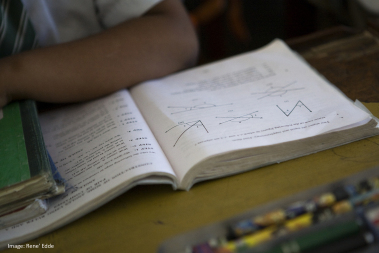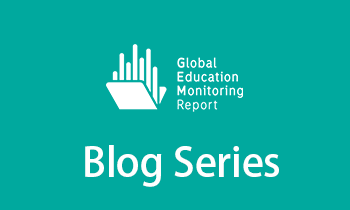By Silvia Montoya, Director of the UNESCO Institute for Statistics (UIS)
 We are on the cusp of a new phase in the global measurement of learning. For the first time, representatives of cross-national learning assessments have agreed on a set of minimum proficiency levels on the reading and mathematical skills that all children need to learn.
We are on the cusp of a new phase in the global measurement of learning. For the first time, representatives of cross-national learning assessments have agreed on a set of minimum proficiency levels on the reading and mathematical skills that all children need to learn.
This exciting new development will be at the top of the agenda of the upcoming meeting of the Global Alliance to Monitor Learning (GAML), which will bring together representatives of countries, assessment agencies, donors and civil society groups from 17-18 October in Hamburg.
At the heart of the matter is SDG Indicator 4.1.1 which measures the proportion of children and young people: (a) grades 2/3; (b) at the end of primary; and (c) at the end of lower secondary achieving at least a minimum proficiency level in (i) reading and (ii) mathematics, by sex.
A major challenge has been to define a standard of minimum proficiency that is widely applicable across countries. To pave the way forward, the UIS brought together representatives of just about every cross-national and regional assessment initiative[1] and brokered an agreement on a proposed set of definitions of the skills and performance levels that all children should acquire.
Proficiency scale to align skills
To do this, they reviewed a list of all the competency levels – from the most basic to the most advanced skills in reading and mathematics – that are currently being assessed. They then agreed to a proposed set of global minimum proficiency levels (MPLs) for each education level measured in Indicator 4.1.1.
This is a groundbreaking agreement. It means that data from all of the major cross-national assessments can be referred to the same MPLs to report SDG 4 data – from the citizen-led assessments conducted by Uwezo in sub-Saharan Africa to the OECD’s Programme for International Student Assessment (PISA). These MPLs, which are shown in the table below, could also be used to map national assessments or serve as reference point for them.
Table 1: Proposed set of minimum proficiency levels for Indicator 4.1.1.
| Education level | General descriptor – Reading | General descriptor – Mathematics |
| Grade 2 | Students read and comprehend most of the written words in an instrument given to them, particularly familiar ones, and extract explicit information from sentences. | Students demonstrate skills in number sense and computation, shape recognition and spatial orientation, with an increase in proficiency between grades 2 and 3. |
| Grade 3 | Students read aloud written words accurately and fluently. They understand the overall meaning of sentences and short texts. Students identify the texts’ topic. | |
| Grades 4 & 6 | Students interpret and give some explanations about the main and secondary ideas in different types of tests. They establish connections between main ideas in a text and their personal experiences as well as general knowledge. | Students demonstrate skills in number sense and computation, basic measurement, reading, interpreting, and constructing graphs, spatial orientation, and number patterns. |
| Grades 8 & 9 | Students establish connections between main ideas on different text types and the authors intentions. They reflect and draw conclusions based on the text. | Students demonstrate skills in computation, application problems, matching tables and graphs, and making use of algebraic representations |
The proposal will be presented for approval to the GAML plenary in Hamburg. While building consensus on the global MPLs, we have also found a technical solution to link existing cross-national and national assessments that improves on the current methods for reporting. This solution can be a better interim solution than the current non-linked reporting, or it can be an ongoing solution where other forms of linking are not possible. (The UIS is also working on making possible other forms of linking, using statistical techniques and item analysis.) This process is called social moderation, or pedagogical linking. By linking different assessments together using the MPLs, the results on minimum proficiency, which is what is required for Indicator 4.1.1., become comparable and it becomes possible for countries to report on the indicator.
 One of the most exciting aspects of this approach is that it is designed to take into account country priorities. Many countries have invested in developing their own national assessments, which reflect their contexts, priorities and curricula. With our proposed methodology, countries can continue to use their own national assessments – but they can now benchmark their progress against a global standard.
One of the most exciting aspects of this approach is that it is designed to take into account country priorities. Many countries have invested in developing their own national assessments, which reflect their contexts, priorities and curricula. With our proposed methodology, countries can continue to use their own national assessments – but they can now benchmark their progress against a global standard.
While ensuring data comparability, social moderation can also help countries deal with some of the inherent difficulties in tracking learning in young children as part of indicator 4.1.1. For example, they can measure fluency in reading by focusing on skills such as accuracy and comprehension, which are less affected by differences across languages.
It is also expected that many of the insights developed via this process of social moderation can also inform other, more statistically-based, methods, over the coming period.
We are ready to upgrade the indicator for young children
Based on these new developments, the UIS has submitted a request to the Inter-agency and Expert Group (IAEG) on the SDGs to upgrade indicator 4.1.1(a) on the early grades of primary from tier 3 to 2:
- Tier 1 indicators are considered to be fully developed;
- Tier 2 indicators are conceptually clear with an established methodology for reporting;
- Tier 3 indicators require considerable methodological development.
Indicators 4.1.1 (b) and (c) on the end of primary and lower secondary education are already classified as tier 2. However, Indicator 4.1.1 (a) on the early grades of primary has been relegated to tier 3 status because there was no way to report results on MPLs for these young learners – until now. Together with Indicator 4.2.1, the upgrading of Indicator 4.1.1 (a) will be a key step in ensuring that young children, whose development is so important to the future of societies, remain a part of the SDG agenda.
Approval from both GAML and the IAEG would be a major step forward for country efforts to report on learning outcomes. These developments will form the basis for measuring learning around the world so that we can account for all children – from primary through secondary school.
Measuring learning outcomes for young children is key to ensuring that they succeed in primary school to avoid the costly churning cycle of grade repetition and eventual dropout that currently impacts children in dozens of countries. I look forward to the fruitful discussions at the GAML meeting. Together, we are paving the way forward to measure and strengthen the learning of children around the world.
[1] SACMEQ was the only cross-national assessment initiative unable to attend the meeting.





Reblogged this on Millennium@EDU SUSTAINABLE EDUCATION.
LikeLike
I think SDG Indicator 4.1.1 was flawed from the beginning. Writing should be added as it represents a core component in literacy development. As for the draft descriptors, I think they are too broad. They are no vigorous indeed. It is very important to raise the awareness of countries, especially underdeveloped countries, of some fundamental concerns. 1- What should students read – Literary vs Informational texts? 2- How much should students read – Simple sentences or stories? How should the reading continuum proceed in terms of quantity, range, and complexity? 4- How much time should be allocated to teaching reading? Daily? Weekly? Yearly?
When I look at the General Descriptor for Reading- Grade 2, I easily observe that it is not vigorous. It is not precise. It could be interpreted in different ways. I think to make sure that the whole world develops in the upcoming years,especially the underdeveloped countries, it is essential to design vigorous and clear frameworks which have the potential to disseminate such invaluable knowledge.
I guess that stating that “Students read and comprehend most of the written words in an instrument given to them, particularly familiar ones, and extract explicit information from sentences” is neithor vigorous nor clear from a curriculum designer.
Best Regards
LikeLike
Pingback: We are now ready to start monitoring early-grade learning | World Education Blog
Pingback: Ahora estamos listos para empezar el seguimiento del aprendizaje en los grados iniciales | Blog de la Educación Mundial
Pingback: We are now ready to start monitoring early-grade learning | Dinezh.com
Pingback: Linking data to get results: India shows how countries can use their national assessments for global reporting | World Education Blog
Pingback: Vincular datos para obtener resultados: India muestra cómo los países pueden usar sus evaluaciones nacionales para informes mundiales | Blog de la Educación Mundial